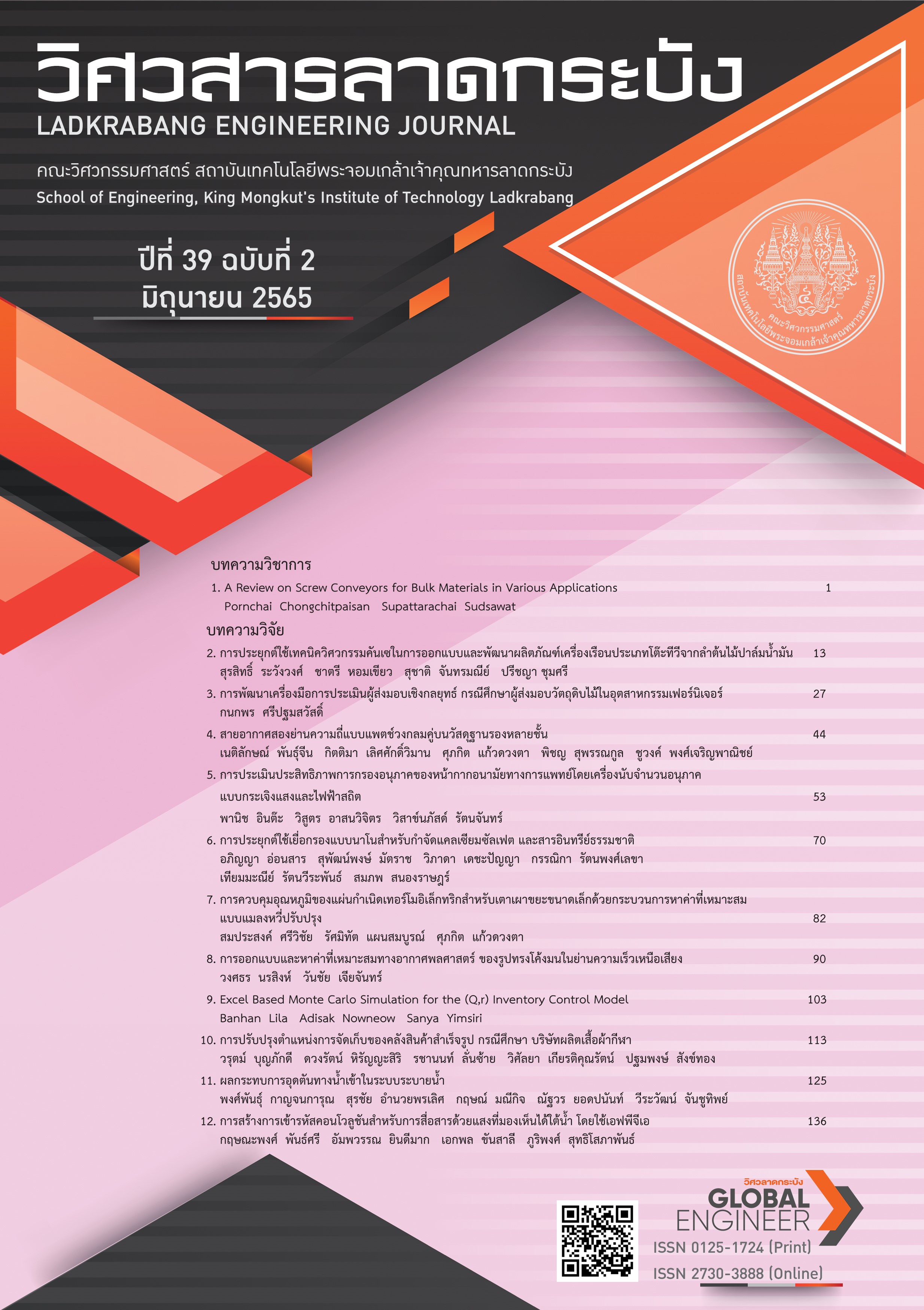การสร้างการเข้ารหัสคอนโวลูชันสำหรับการสื่อสารด้วยแสงที่มองเห็นได้ใต้น้ำ โดยใช้เอฟพีจีเอ
คำสำคัญ:
การสื่อสารใต้น้ำ, การสื่อสารเชิงแสงที่มองเห็นได้สำหรับการส่งข้อมูลค่า pH และ อุณหภูมิ, การเข้ารหัสคอนโวลูชันด้วยใช้, อุปกรณ์ลอจิกแบบโปรแกรมได้บทคัดย่อ
บทความนี้นำเสนอการออกแบบและทดลองระบบการเข้ารหัสคอนโวลูชัน (Convolutional code) เพื่อแก้ไขบิตผิดพลาดโดยใช้อุปกรณ์ลอจิกแบบโปรแกรมได้ (Field programmable gate array: FPGA) สำหรับการสื่อสารเชิงแสงที่มองเห็นได้ใต้น้ำ (Underwater visible light communication: UVLC) โดยใช้อัลกอริทึมวิเทอบิ (Viterbi algorithm) สำหรับการถอดรหัสเพื่อแก้ไขบิตผิดพลาด ส่วนของเครื่องส่งถูกวางไว้ใต้น้ำโดยใช้ค่าอุณหภูมิในน้ำ และค่าพีเอช (pH) เป็นตัวอย่างในการศึกษาการรับส่งข้อมูลเชิงแสงใต้น้ำไร้สายโดยใช้แอลอีดี (Light emitting diode: LED) ที่กำลังงาน 10W และอัตราบอด (Baud rate) สูงสุดเท่ากับ 9,600 b/s (baud per second) ส่วนที่เครื่องรับก็จะใช้อวาแลนช์โฟโตไดโอด (Avalanche photodiodes: APD) ที่มีแถบสัญญาณเท่ากับ 25 MHz สำหรับการแปลงสัญญาณเชิงแสงให้เป็นสัญญาณทางไฟฟ้า APD จะถูกใช้ตัวรับแสงพร้อมกันที่เครื่องรับทั้งหมด 4 ตัวและ สัญญาณจาก APD จะถูกนำไปขยายด้วยออปแอมป์เบอร์ OPA2380 เพื่อให้ได้แรงดันไม่ต่ำกว่า 3.3V เนื่องจากเป็นแรงดันที่ ESP8266 WiFi ทำงานได้ ลำดับสุดท้าย ข้อมูลค่าอุณหภูมิและพีเอชที่ตรวจรู้ได้นี้จะถูกส่งไปยังเครื่องแม่ข่ายคลาวด์ NETPIE และแสดงผลบนเว็บไซต์ เพื่อยืนยันการทำงานของระบบผลการทดลองที่จะทำการบันทึกและแสดงผลต่อเนื่อง 240 นาที ที่ระยะทาง 1.5 m โดยมีอัตราบิตผิดพลาดเท่ากับ 1.4 × 10-3 จากผลการทดลองพบว่าการเข้ารหัสคอนโวลูชันสามารถแก้ไขบิตผิดพลาดได้ และระบบสามารถทำงานได้ดีแสดงค่าที่ตรวจรู้ได้ตลอด การทดลองนี้เป็นการทดลองบนเวลาจริง (Real Time)
References
H. Kaushal and G. Kaddoum, “Underwater optical wireless communication,” IEEE Access, vol. 4, pp. 1518–1547, 2016, doi: 10.1109/ACCESS.2016.2552538.
T. Szili, B. Matolcsy and G. Fekete, “Water pollution investigations by underwater visible light communications,” in The 17th International Conference on Transparent Optical Networks (ICTON), Budapest, Hungary, 2015, pp. 1–4, doi: 10.1109/ICTON.2015.7193516.
S. Watson, S. P. Najda, P. Perlin, M. Leszczynski, G. Targowski, S. Grzanka, M. A. Watson, H. White and A. E. Kelly, “Multi-gigabit data transmission using a directly modulated GaN laser diode for visible light communication through plastic optical fiber and water,” in 2015 IEEE Summer Topicals Meeting Series (SUM), Nassau, Bahamas, 2015, pp. 224–225, doi: 10.1109/PHOSST.2015.7248278.
K. Nakamura, I. Mizukoshi and M. Hanawa, “Optical wireless transmission of 405 nm, 1.45 Gbit/s optical IM/DD-OFDM signals through a 4.8 m underwater channel,” Optics Express, vol. 23, no. 2, pp. 1558–1566, 2015, doi: 10.1364/OE.23.001558.
S. Andreas, C. Olivier, S. Bruno, C. Tobias, S. Arne and G. Seabear, “Underwater monitoring system for body temperature and ECG recordings,” Underwater Technology, vol. 34, no. 3, pp.135–139, 2017, doi: 10.3723/ut.34.135.
K. Puntsri, E. Khansalee and P. Suttisopapan, “Underwater environment sensors with visible light communication systems,” Journal of Current Science and Technology, vol. 11, no. 2, pp. 269–276, 2021, doi: 10.14456/jcst.2021.27.
Z. Decai, L. Xiaochun, W. Haitao and X. Jinsong, “Implementation of convolutional code based on FPGA in OFDM-UWB system,” in The 2008 3rd IEEE Conference on Industrial Electronics and Applications, Held, Singapore, pp. 1119–1122, 2008, doi: 10.1109/ICIEA.2008.4582692.
B. Sklar, “Channel Coding: Part2,” in Digital communications: fundamentals and applications, Hoboken, NJ, USA: Prentice Hall, 2001, ch. 7, sec. 7.1, pp. 381–435.
W. C. Cox, J. A. Simpson, C. P. Domizioli, J. F. Muth and B. L. Hughes, “An underwater optical communication system implementing Reed-Solomon channel coding,” in OCEANS 2008, QC, Canada, 2008, pp. 1–6,doi: 10.1109/OCEANS.2008.5151992.
J. Zhang, Y. Yang, Z. Gao, Y. Zhu, “Performance analysis of LDPC codes for wireless optical communication systems in different seawater environments,” in 2018 Asia Communications and Photonics Conference (ACP), Hangzhou, China, 2018, pp. 1–3, doi: 10.1109/ACP.2018.8596282.
G. S. Spagnolo, L. Cozzella and F. Leccese, “Underwater optical wireless communications: overview,” sensors, vol. 20, no. 8, pp. 1–14, 2020, doi: 10.3390/s20082261.
M. Jahanbakht, W. Xiang, L. Hanzo and M. Rahimi Azghadi, “Internet of underwater things and big marine data analytics—a comprehensive survey,” IEEE Communications Surveys & Tutorials, vol. 23, no. 2, pp. 904–956, 2021, doi: 10.1109/COMST.2021.3053118.
B. Cochenour, K. Dunn, A. Laux and L. Mullen, “Experimental measurements of the magnitude and phase response of high-frequency modulated light underwater,” Applied Optics, vol. 56, no. 14, pp. 4019–4024, 2017, doi: 10.1364/AO.56.004019.
Downloads
เผยแพร่แล้ว
How to Cite
ฉบับ
บท
License
Copyright (c) 2022 คณะวิศวกรรมศาสตร์ สถาบันเทคโนโลยีพระจอมเกล้าเจ้าคุณทหาร

This work is licensed under a Creative Commons Attribution-NonCommercial-NoDerivatives 4.0 International License.
บทความที่ได้รับการตีพิมพ์เป็นลิขสิทธิ์ของคณะวิศวกรรมศาสตร์ สถาบันเทคโนโลยีพระจอมเกล้าเจ้าคุณทหารลาดกระบัง
ข้อความที่ปรากฏในบทความแต่ละเรื่องในวารสารวิชาการเล่มนี้เป็นความคิดเห็นส่วนตัวของผู้เขียนแต่ละท่านไม่เกี่ยวข้องกับสถาบันเทคโนโลยีพระจอมเกล้าเจ้าคุณทหารลาดกระบัง และคณาจารย์ท่านอื่นๆในสถาบันฯ แต่อย่างใด ความรับผิดชอบองค์ประกอบทั้งหมดของบทความแต่ละเรื่องเป็นของผู้เขียนแต่ละท่าน หากมีความผิดพลาดใดๆ ผู้เขียนแต่ละท่านจะรับผิดชอบบทความของตนเองแต่ผู้เดียว






